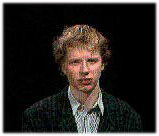
Maurice
If you use the button 'continue' you see visual output of some physiological variables of MAURICE (over 24 hours). The two most important variables are his cardiac output (CO) (blue) and his main arterial blood pressure (AP) (red). After some time (here 60 minutes) somethings is happens to MAURICE (acute). After that moment you have to do something, otherwise MAURICE will give some terrible feedbacks. You have about 300 (simulated) minutes time to play the rule of a good coming new doctor.
The counter at the bottum - left - is the simulation time in minutes (Tijd). The red 'growing' graph is the (mean) arterial pressure (AP) (in mmHg); the green graph is the heart rate (HR); the yellow graph is the urine output (UO); the blue one the cardiac output (CO) (the amount of blood through the heart in one minute).

Remark that MAURICE can say somethings if you do the wrong thing or nothing. A video-window is (than) coming up. If you do the just thing (the just therapy) (and you give the good medicine and also the best amount of them) than you see the most variables go back to normal.
(I call that 'intelligent feedback' and that will be generated by a model-driven rule base).
Other remarks (about the model-interventions at the left): 'Nierfunctie' is the dutch word for 'renal mass' (RM). 'Hartfunctie' is the dutch word for 'basic heart strength' (HSB). 'Drinken' is the dutch word for 'water intake' (WIN) and 'digitalis' is the dutch word for the medicine 'cardiac glycosides' or 'digitalis' (DIGI).
In Dutch: Het is - onderwijskundig gezien - de bedoeling dat je in dit soort interactieve leeromgevingen, uit de beperkte feedback, uit de beperkte gegevens en signalen, (vlug maar gedegen) een echte diagnose leert stellen. Je hebt meestal ongeveer een uur (in simulatie-tijd-termen gesproken) om de patient te behandelen: een therapie toe te passen. Je kunt (online) drie soorten therapieën geven. Als je niks doet blijft de patient soms in leven, maar soms gaat hij 'echt' dood.
This simulation and instruction environment is realized with the JavaTHESIS-system, version 3.9x (1999) of Rik Min (designer), Jacob Sikken (first version) and Jan de Goeijen (latest versions).
Rik Min, Enschede, june 6, 2000.
